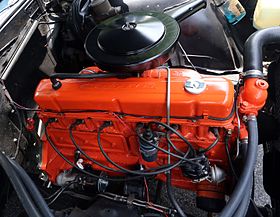Blue Flame (engine)
| Straight 6 | |
|---|---|
| Overview | |
| Manufacturer | General Motors Corporation |
| Production | 1929–1990 North America 2002–2009 (Atlas LL8) North America 1962–2001 Brazil |
| Combustion chamber | |
| Valvetrain | OHV |
| Combustion | |
| Fuel type | gasoline |
| Cooling system | water-cooled |
| Chronology | |
| Predecessor | 171 Straight-4 |
| Successor | General Motors 90° V6 engine |
| First Generation | |
|---|---|
 |
|
| Overview | |
| Production | 1929–1936 |
| Combustion chamber | |
| Displacement | 194 cu in (3.2 L) 181 cu in (3.0 L) 207 cu in (3.4 L) |
| Cylinder bore | 3.3125 in (84 mm) |
| Piston stroke | 3.75 in (95 mm) |
| Valvetrain | OHV |
| Combustion | |
| Oil system | "splash" lubrication for the rod bearings and pressurized lubrication to the three main bearings. |
| Cooling system | Water-cooled |
| Output | |
| Power output | 50 hp (37 kW) 1929–1931 194 60 hp (45 kW) 1932–1933 194 80 hp (60 kW) 1934–1936 194 |
| Chronology | |
| Predecessor | 171 Straight-4 |
| Second generation | |
|---|---|
| Overview | |
| Production | 1937–1963 US -1964 Brazil |
| Combustion chamber | |
| Displacement | 216 cu in (3.5 L) 235 cu in (3.9 L) 261 cu in (4.3 L) |
| Cylinder bore | 3.500 in (88.9 mm) 3.5625 in (90.5 mm) 3.750 in (95.2 mm) |
| Piston stroke | 3.750 in (95.2 mm) 3.9375 in (100 mm) |
| Valvetrain | OHV |
| Compression ratio | 6.5:1 6.6:1 7:1 |
| Combustion | |
| Cooling system | Water-cooled |
| Output | |
| Power output | 85 hp (63 kW) 90 hp (67 kW) 92 hp (69 kW) 123 hp (92 kW) 136 hp (101 kW) 150 hp (112 kW) |
| Third generation | |
|---|---|
 |
|
| Overview | |
| Production | 1962—1990 1964—2001 (Brazil) |
| Combustion chamber | |
| Displacement | 194 cu in (3.2 L) 230 cu in (3.8 L) 250 cu in (4.1 L) 292 cu in (4.8 L) |
| Cylinder bore | 3.563 in (90.5 mm) 3.875 in (98.4 mm) 3.875 in (98.4 mm) 3.875 in (98.4 mm) |
| Piston stroke | 3.250 in (82.6 mm) 3.250 in (82.6 mm) 3.530 in (89.7 mm) 4.120 in (104.6 mm) |
| Valvetrain | OHV |
| Combustion | |
| Cooling system | Water-cooled |
| Dimensions | |
| Length | 32.5 in (830 mm) |
The Chevrolet inline 6 otto engine was Chevrolet's sole engine from 1929 (when it replaced their first 4-cylinder engine, the 171-cubic-inch four), through 1954, and was the base engine starting in 1955 when they added the small block V8 to the lineup. It had finally been completely phased out by 1990 in North America, but in Brazil, GM held on to their fuel-injected version through the 1998 model year. It was replaced by more recently developed V6 and four-cylinder engines. Many popular cars and trucks, including the Chevrolet Camaro, Chevrolet Impala, and Chevrolet Suburban used the inline 6 as the base engine. Chevrolet did not offer another inline 6 until the 2002 General Motors Atlas engine's debut in the Chevrolet TrailBlazer.
The first mass-produced GM inline 6 was introduced in 1929 on Chevrolet cars and trucks, replacing the company's first inline-4. Richard Grant (Chevrolet marketing executive) insisted that the new design boast overhead valves. Chevrolet had long been known for its "valve-in-head" four-cylinder engines. William S. Knudsen's cast-iron wonder was produced through 1936.
It was 193.9 cubic inches (3.2 L) in size and produced 50 hp (37 kW). This engine used a forged steel crankshaft with three bearings and cast-iron pistons. Bore and stroke was 3.3125 in (84.14 mm) by 3.75 in (95.25 mm). The 194 was shared with Chevrolet and GMC trucks for 1935 and 1936.
A balanced crankshaft was introduced for 1932, while a higher (5.2:1) compression ratio upped output to 60 hp (45 kW). Applications:
...
Wikipedia
